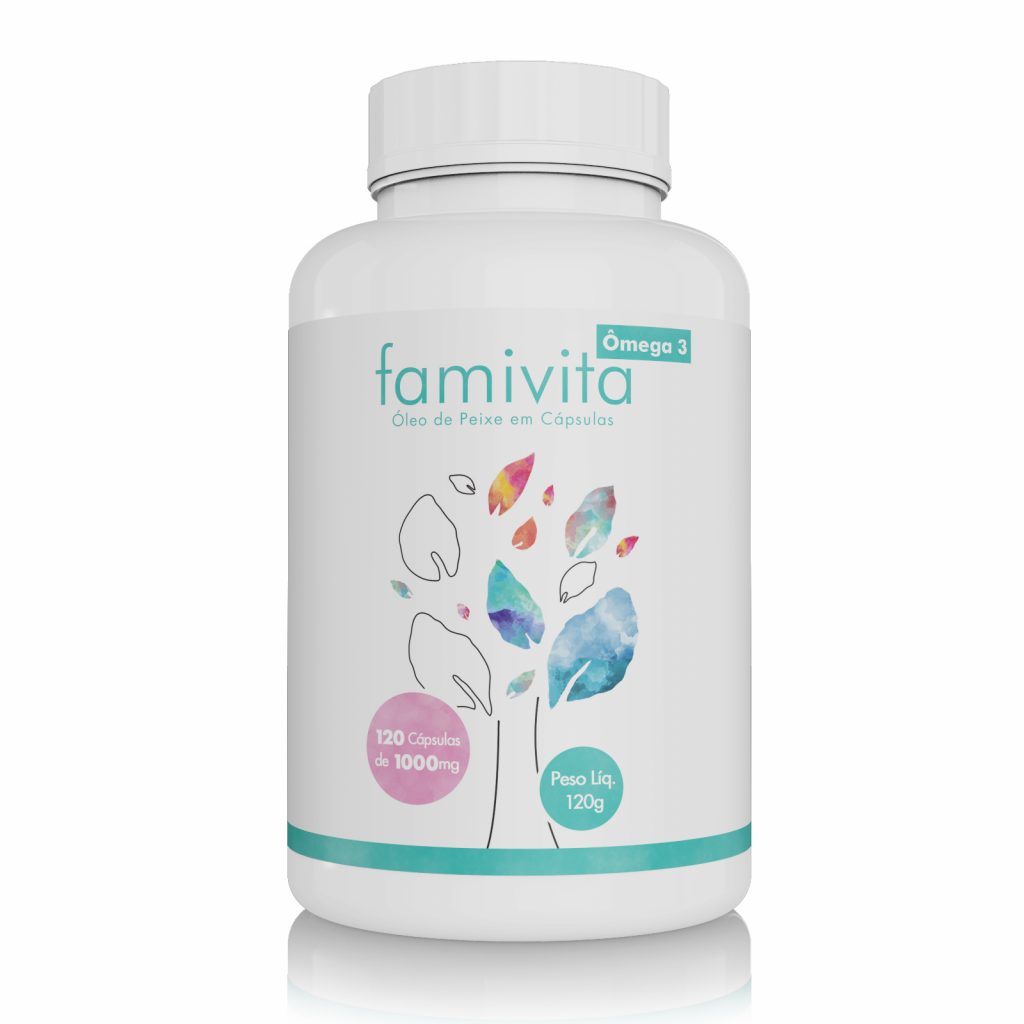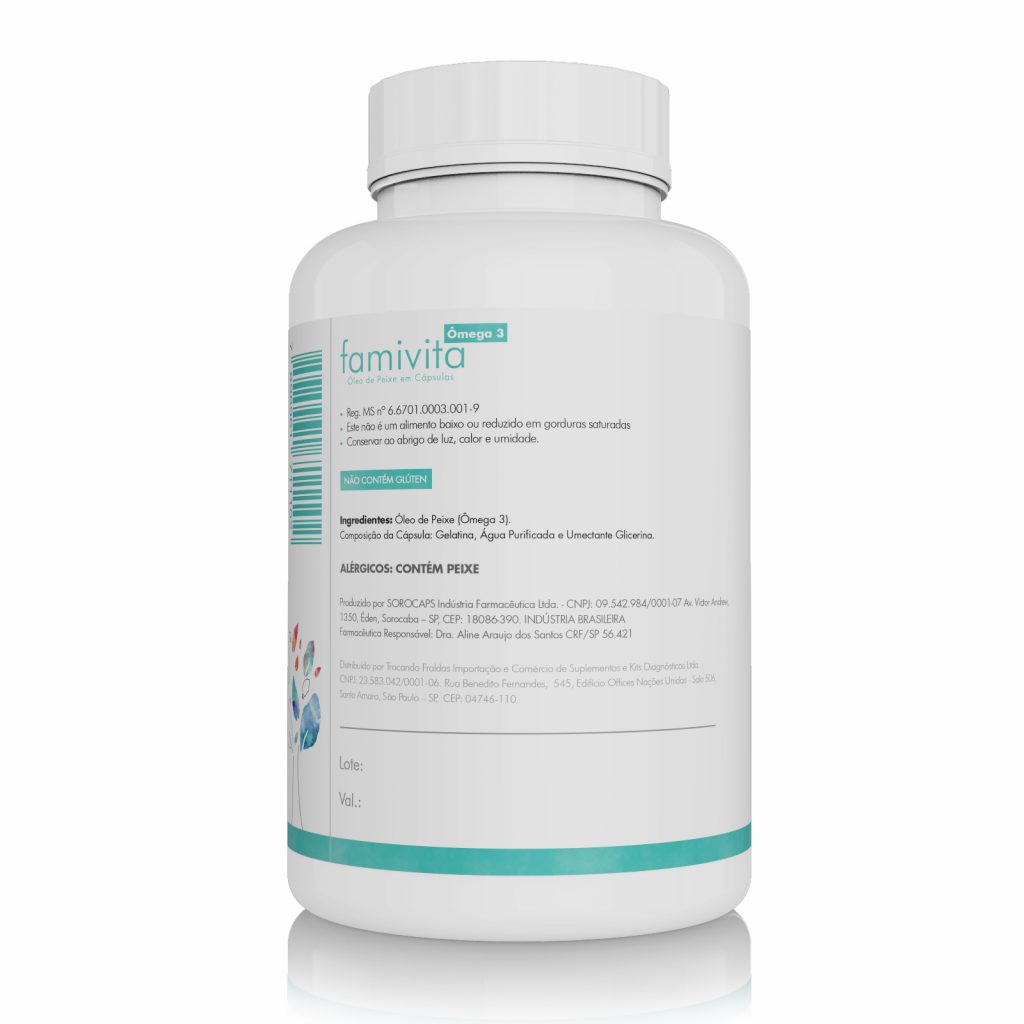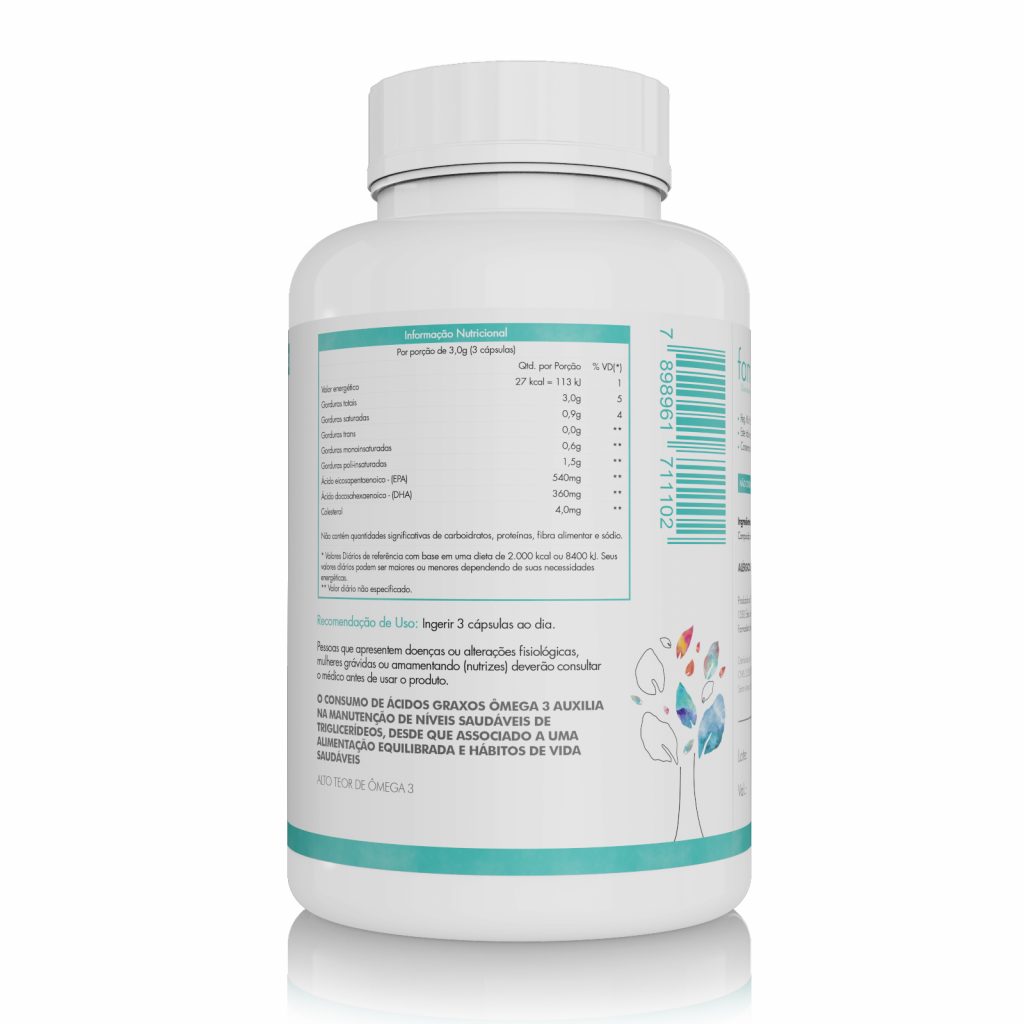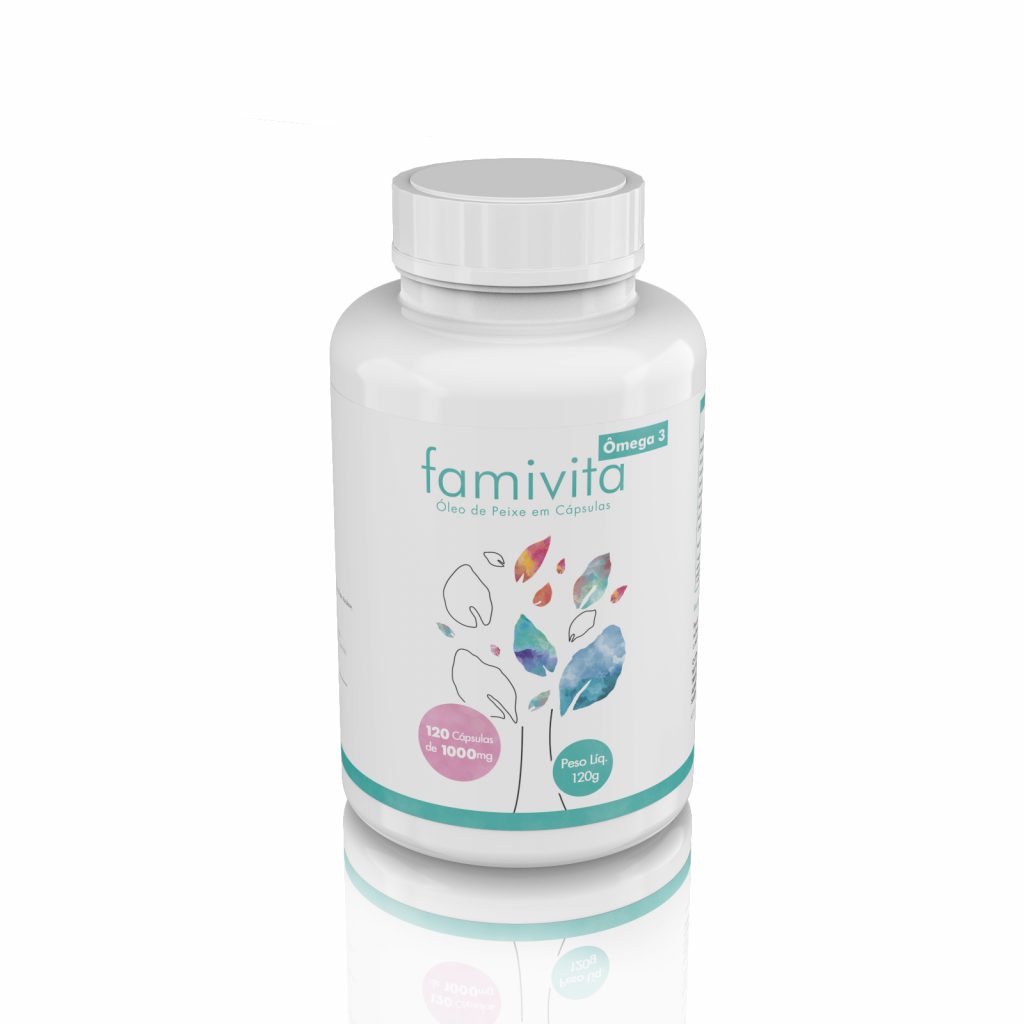Omega 3 Features
- Beneficial Fat for the Body
- Ideal for Pregnant Women, Brain, and Heart
- Take 1 to 2 Capsules per Day
- Ships within 24 business hours
- Over 20,000 orders shipped
- 30-day return policy

- What is Omega 3
- What is it for
- How to Take
- Omega 3 for Conception and Pregnancy
- Side Effects – Does it Cause Weight Gain or Loss?
- How Much Does Omega 3 Cost
What is Omega 3 or Fish Oil
Omega 3, or fish oil, also known as a fatty acid, is a polyunsaturated carboxylic acid that is called essential because it is not synthesized by the body and must be obtained exclusively through diet. The most common ways to get these fatty acids are from certain vegetable oils such as flaxseed oil, algae oil, avocado, walnuts, almonds, sesame, flaxseed, sunflower, but also and especially in fish oils. Omega 3 is often found in larger amounts in fish such as salmon, sardines, cod, and tuna. Omega 3 is divided into two categories: long-chain and short-chain, with the long-chain being the most recommended for our health, as it provides more health benefits. Foods rich in omega 3 are easily found in supermarkets and the like, but there are also supplements and capsules that can be found in pharmacies and major drugstores, preferably used with medical advice, but with no contraindications, even for patients with high cholesterol. The composition of omega 3: alpha-linolenic acid (ALA), eicosapentaenoic acid (EPA), and docosahexaenoic acid (DHA), with EPA and DHA being found in most of the fish listed above. 
What is it for
Omega 3 offers great benefits for our health, as it acts powerfully on the circulatory system and especially on the heart. It decreases blood platelets, reducing the chance of clotting that can lead to strokes (CVA, cerebrovascular accident) or heart attacks. In addition, it brings advantages for: mood
learning
the immune system
One of its main benefits is its anti-inflammatory power, as it reduces levels of prostaglandins produced by the body, which would otherwise increase the formation of inflammation throughout the body. Furthermore, omega 3 is also quite efficient when it comes to the risk of thrombosis, as it helps to drastically reduce the chances for those who are prone to developing this condition. A great thing about omega 3 is the way it works in the body—it helps prevent blood vessels from becoming clogged. It also reduces levels of cholesterol and triglycerides, which are also fats that can cause a lot of health problems when elevated. People with high levels of LDL cholesterol—the harmful type—are advised to consume omega 3 or fish oil to help reduce it. Another benefit of fish oil is that it increases good cholesterol, HDL. With higher levels of HDL, the body processes and eliminates bad cholesterol more effectively. In addition, omega 3 helps control blood pressure, prevents the formation of fatty plaques on artery walls, thus reducing the risk of high blood pressure, heart attack, and strokes, commonly called a stroke. Omega 3 also lowers the risk of developing diseases such as diabetes, some types of cancer, and directly improves brain function by increasing concentration and memory. People with low immunity are also excellent candidates for omega 3 supplementation, such as the elderly and children, as well as individuals with specific diseases like sickle cell anemia and autoimmune disorders such as lupus and fibromyalgia. In winter, when there are many illnesses (such as the flu and colds), it acts as a cell strengthener and helps fight viruses before they manifest. 
How to Take
Unfortunately, to consume an adequate amount of omega 3, you need to eat certain foods daily, and one of them—fish—is not commonly eaten by Brazilians, either due to cost or habit. Ideally, you should eat fish rich in omega 3 at least 2 times per week to reach the minimum required amount in the body. However, since not all foods contain omega 3, and not all regions of the country have a wide variety available, intake can also be done via supplementation, which can be more practical due to a busy lifestyle. Check out some main consumption tips: Consumption via capsules is not recommended for children and should only be done through food. However, pregnant women, elderly people, and individuals with high cholesterol can take the supplement, ideally at least twice a day, before or after meals. Choose reputable brands that are free of heavy metals such as mercury and oxidized oil, known as compounded omega 3. The ideal omega 3 is pure and derived from fish. Prefer gel capsules or liquid forms—many people blend them with a beverage, but they can also be swallowed like a regular pill. Another option is to take cod liver oil, which, despite its strong taste and smell, is one of the safest sources as it is very rich in fatty acids. However, since it is not palatable for everyone, capsules are recommended to reduce discomfort. Cod liver oil is also available in capsules. Besides containing omega 3, they are rich in vitamins A and D. But caution is needed, as you shouldn’t take them alongside other supplements, as excessive vitamin A becomes toxic and can pose serious health risks. If ingested via food, it is recommended at least 2 times per week, with sources like fish, flaxseed, chia, leafy greens such as kale and spinach, and even extra virgin olive oil. There are, however, different recommendations for children and pregnant women. The daily intake for babies between 6 and 24 months is 50 to 100 mg, to be distributed in the diet about 2 times a week. For pregnant and breastfeeding women, it is 400 mg, distributed over 4 times a week. Children and adolescents aged 2 to 18 should take 250 mg daily, spread over 3 to 4 times a week. Foods rich in omega 3 should not be fried, as high heat destroys the beneficial properties of the fatty acids. Therefore, the best ways to prepare these foods are grilled, cooked, or even raw. If you choose to cook them, always use low heat. Nowadays, the food industry has invested heavily in producing foods containing omega 3, such as butters, yogurts, or milk, but few labels disclose what type of omega 3 is used. Remember that short-chain omega 3 does not provide the same benefits as long-chain omega 3, so always check the type used. Always read the label, and if in doubt, contact the manufacturer to find out which type of omega 3 you are consuming. 
Omega 3 for Conception and During Pregnancy
For those hoping to conceive, omega 3 is a strong ally. Nowadays, fish oil is often cited as a great aid for women trying to become pregnant, as omega 3 works in the body to strengthen the ovaries and thereby promotes proper growth of ovulatory follicles. A recent study also found that women with polycystic ovaries tend to have ovarian inflammation, which hinders proper egg development for conception, so they greatly benefit from the anti-inflammatory effects of omega 3. For men wishing to father a healthy child, fish oil intake promotes the healthy development of sperm, producing sperm with higher quality and proper morphology, thus helping to avoid malformed sperm (with two tails, two heads, no tails, no heads, etc.). The ideal for those trying to conceive is to consume omega 3 together with folic acid and B-complex vitamins; this trio supports the proper creation of gametes (eggs and sperm) and leads to a healthier embryo and lowers the risk of miscarriage due to malformation. Good nutrition during pregnancy is essential for a healthy pregnancy and a healthy baby. Therefore, supplements are recommended to help during this stage. In the case of omega 3, if the pregnant woman is not getting enough through diet, supplementation may be a good option as long as it is from a reputable source. Ideally, at least 400 mg and up to 600 mg weekly should be taken. It is important that, in addition to supplementation, the pregnant woman’s diet also includes foods containing these fatty acids. Of course, the obstetrician or nutritionist can recommend supplements if necessary. The effectiveness of omega 3 in pregnancy has been proven for preventing premature births and producing stronger, healthier children, in addition to providing considerable anti-inflammatory and antithrombotic benefits, which are essential during pregnancy. Women with a tendency toward thrombophilia or who are being treated with specific medication during pregnancy should use omega 3 to help prevent circulatory problems for both mother and baby. Omega 3 also helps prevent clots that can form in the umbilical cord—a cause of neonatal death in many cases. Taking omega 3 during pregnancy brings greater peace of mind, better tissue support, improved blood flow, and better health for both mother and baby, who will enjoy the benefits of these nutrients for healthy development. The risk of preeclampsia is also reduced with proper omega 3 use. Recent studies show that babies of mothers who took adequate amounts of omega 3 during pregnancy have better memory, cognitive, and motor skills during the first 3 years of life.
Side Effects – Does it Cause Weight Gain or Loss?
Even though it’s a substance so beneficial to health, as with herbs, there can be side effects. When taken as capsules, especially in the first few weeks, bad breath and a feeling of indigestion, acid reflux, and increased burping are common. As it is a very oily fat, it can cause diarrhea or oiliness in stools. Because omega 3 acts directly on blood pressure, high doses can increase the risk of nosebleeds and non-severe blood vessel accidents. As a fat, consuming it in amounts far above what’s recommended can lead to uncontrolled weight gain, so it should always be taken according to the dose prescribed by a specialist. When used moderately, omega 3 can be a strong ally in weight loss. If taken together with exercise and a balanced diet, its anti-inflammatory power acts as a weight-loss booster by burning abdominal fat and helping to control glycemic levels and eliminate belly fat.
How Much Does Omega 3 Cost
The price of omega 3 can vary depending on the type of supplement used. When obtained through food alone, it is difficult to define a value. However, for softgel capsules, the cost is easier to predict. There are supplements for every budget, ranging from R$5 to R$190.00, but not all offer the same quality. As noted earlier, there are two types of omega 3—with the long-chain variety being ideal. On average, good products cost around R$30.00. A bottle with 60 capsules lasts for 30 days if taken in two daily doses. Remember, it’s always good to talk to a nutritionist about your ideal dose, whether you are an adult, pregnant woman, or elderly person.












Virginia Motta
verified buyer August 23, 2016
I hate taking medicine, especially oil capsules, but on my gym instructor’s advice I decided to try omega 3. I didn’t like the taste, but I only noticed it in the first days and I got used to it. After doing some research, I ended up buying from this site and received it quickly at home, plus it was the best price I found for that quantity of capsules.
Cassandra Farias
verified buyer August 15, 2016
My doctor prescribed omega 3 to improve my quality of life and help me lose weight so I could get pregnant more easily. I’ve been taking it along with exercises like walking and swimming and I’ve already lost some weight. I had mild diarrhea at first, but my body has since adjusted to the oil and I’m feeling much more energetic.
Andrea Souza
verified buyer July 2, 2016
Because of a hectic daily routine, I was feeling very exhausted and unmotivated. My work performance had deteriorated a lot and I couldn’t do my tasks as before. After reading about omega 3’s benefits on this site, I decided to buy it to try and I liked the improvement I noticed. The downside is the aftertaste that lingers in the mouth a few minutes after taking it, but I did notice an improvement in my energy.